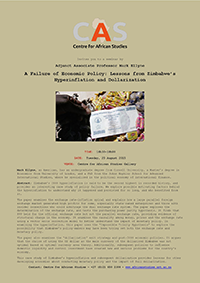
Abstract: Zimbabwe’s 2008 hyperinflation is said to be the second highest in recorded history, and provides an interesting case study of policy failure. We explore possible motivating factors behind the hyperinflation to understand why it happened and persisted for so long, and who benefited from it.
The paper examines the exchange rate–inflation spiral and explains how a large parallel foreign exchange market generated high profits for some, especially state-owned enterprises and those with insider connections who could arbitrage the dual exchange rate system. The paper explores the determination of the exchange rate, and tests the purchasing power parity hypothesis. It finds that PPP held for the official exchange rate but not the parallel exchange rate, providing evidence of structural change in the economy. It examines the causality among money, prices and the exchange rate using a vector error correction model to better understand the impact of monetary policy. In examining the hyperinflation, this paper uses the “Impossible Trinity Hypothesis” to explore the possibility that Zimbabwe’s policy-makers may have been trying set both the exchange rate and monetary policy.
The paper also examines the “dollarization” exit strategy and post-2008 economic policies. It argues that the choice of using the US dollar as the main currency of the dollarized Zimbabwe was not optimal based on optimal currency area theory. Additionally, subsequent policies to influence domestic liquidity and control investment have created new and serious problems for the country’s economy.
This case study of Zimbabwe’s hyperinflation and subsequent dollarization provides lessons for other developing economies about conducting monetary policy and the impact of full dollarization.
Event type: Seminar
Date of event: Tuesday, August 25, 2015
Venue: Centre for African Studies Gallery
